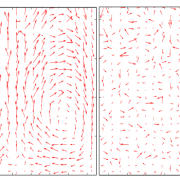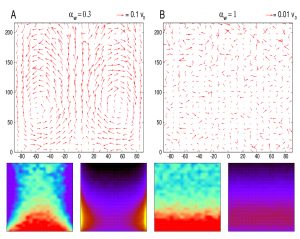Granular fluids and their non-equilibrium phases
Take a glass jar, pour in it some sand and shake it violently: you will get a granular fluid. Very simple to create, very complex to be understood. Indeed the whole theoretical apparatus developed in the 20th century to study molecular phases (equilibrium statistical mechanics) is inadequate for granular fluids.
A few years ago, Andrea Puglisi together with two colleagues and friends from the Firenze University (Franco Bagnoli and Alessio Guarino), have built a prototype of granular fluid experiment in two dimensions, using a woofer and an amplifier from a stereo hi-fi set, steel spheres and a flat (glass) surface. A video of this prototype became quite popular:
The video shows the huge variety of striking phenomena appearing when the “temperature” (amplitude of vibration of the woofer) goes from very low to very high: ordered phase -> rare fluctuations -> liquid phase sustained by a lower gas-like phase (“Leidenfrost” state) -> convective cells -> bubbles/rogue waves -> phase separation (liquid-gas) -> granular gas
Recently the granular group in ISC Sapienza (Andrea Puglisi, Giorgio Pontuale and Andrea Gnoli, in collaboration with Francisco Vega-Reyes from Extremadura University) have published an experimental and numerical study of granular convection in the fluid state, demonstrating that the dissipation of kinetic energy in the collisions between spheres and the lateral walls is sufficient to trigger it. The experiment is summarised in this video:
The difference of the velocity (top), temperature (bottom left) and density (bottom right) fields visibile in the figure is triggered by a change in the restitution coefficient for the particle-wall collisions (inelastic on the left, elastic on the right). The results in the figure are from numerical simulations and are in fair agreement with the experiments.
G. Pontuale, A. Gnoli, F. Vega Reyes, A. Puglisi
Thermal convection in granular gases with dissipative lateral walls
Phys. Rev. Lett. 117, 098006 (2016)




